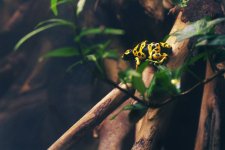The Fascinating Adaptations of Poison Dart Frogs
Poison dart frogs, vibrant and captivating amphibians, inhabit the tropical rainforests of Central and South America. Renowned for their striking coloration and potent toxins, these small frogs have developed remarkable adaptations that ensure their survival in their diverse habitats. This article delves into the various adaptations of poison dart frogs, exploring their physical characteristics, behaviors, and the ecological roles they play.
Physical Adaptations of Dart Frogs: Coloration and Toxicity

One of the most notable adaptations of poison dart frogs is their bright coloration, which serves as a warning signal to potential predators. This aposematic coloration is a classic example of nature's way of advertising danger. The vivid colors range from blue, yellow, red, green, to orange, often accompanied by dark blue and black spots. These colors are not just for show; they signify the presence of toxic compounds in the frogs' skin.
The toxins present in poison dart frogs are alkaloids, which they derive from their diet of small insects, including ants, beetles, and termites. These toxins can cause severe discomfort, paralysis, or even death to predators that attempt to consume them. The skin of a poison dart frog contains these toxins, making them unpalatable to would-be predators. In captivity, where their diet consists of non-toxic insects like fruit flies and crickets, poison dart frogs do not produce these potent toxins.
Behavioral Adaptations: Reproduction and Parental Care
Poison dart frogs exhibit fascinating reproductive behaviors and parental care strategies. During the rainy season, male frogs engage in vocalizations to attract a female. Once a pair has formed, the female lays eggs on the forest floor or on leaves near small bodies of water. These eggs are often found near bromeliads, plants that hold small pools of water, providing a safe environment for the developing tadpoles.
After hatching, the larva undergoes metamorphosis in these pools of water. The male or female poison dart frog exhibits parental care by transporting the tadpoles on their backs to larger, safer bodies of water. This ensures the tadpoles have a higher chance of survival. The entire process, from egg to adult frog, can take several weeks to undergo metamorphosis.
Ecological Role and Diet
Poison dart frogs play a crucial role in their ecosystems as both predator and prey. They are diurnal, meaning they are active during the day, which sets them apart from many other amphibians. As predators, they consume a variety of small insects, such as ants, termites, spiders, and beetles. Their sticky tongues allow them to efficiently capture their prey. Scientists believe that the specific diet of these frogs, especially the consumption of certain arthropods, contributes to the production of their toxic skin compounds.
In their role as prey, poison dart frogs have adapted by developing their potent toxins and bright coloration to deter predators. However, despite these defenses, they still face threats from larger animals and humans. Habitat destruction due to deforestation and climate change poses significant risks to their populations.
Tropical Rainforest Habitat and Distribution

Poison dart frogs are primarily found in the tropical rainforests of Central and South America, including countries like Costa Rica, Bolivia, Suriname, and regions within the Amazon rainforest. They thrive in these humid, warm environments where there is abundant rainfall. These frogs live in various microhabitats, from the forest floor to the canopy, often near small bodies of water necessary for their reproductive cycle.
Human Impact and Conservation Efforts
Human activities have greatly impacted poison dart frog populations. Habitat destruction due to logging, agricultural expansion, and urbanization has led to significant declines in their numbers. Conservation programs have been established to protect these amphibians and their habitats. Captive breeding programs aim to preserve genetic diversity and reintroduce frogs into the wild.
Scientists are also researching the potential use of poison dart frog toxins in pharmaceuticals. These toxic compounds have shown promise in developing new medicines for pain relief and other medical applications. This adds an additional layer of importance to conserving these unique amphibians.

Interesting Facts and Species Highlights
- Blue Poison Dart Frog (Dendrobates tinctorius "azureus"): Known for its striking blue coloration with dark spots, this species is a favorite among researchers and enthusiasts.
- Poison Dart Frog Dendrobates: This genus includes several species with varying patterns and colors, all sharing the common trait of toxicity.
- Poison Dart Frogs Live in Tropical Rainforests: These ecosystems provide the necessary environment for their survival, with high humidity and plenty of hiding spots.
- Poison Dart Frogs Eat Small Insects: Their diet includes ants, termites, beetles, spiders, and other arthropods, which contribute to their toxic skin compounds.
Conclusion
Poison dart frogs are a testament to the incredible adaptability of nature. Their vibrant coloration, toxic skin, unique reproductive behaviors, and ecological roles highlight the complexity and beauty of these amphibians. As their habitats face increasing threats from human activities, it is crucial to continue conservation efforts to protect these remarkable creatures. By understanding and preserving poison dart frogs, we not only safeguard a vital part of our planet's biodiversity but also potentially uncover new scientific and medical advancements.


